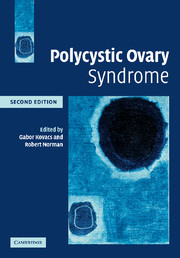Book contents
- Frontmatter
- Contents
- List of contributors
- 1 Introduction: Polycystic ovary syndrome is an intergenerational problem
- 2 Introduction and history of polycystic ovary syndrome
- 3 Phenotype and genotype in polycystic ovary syndrome
- 4 The pathology of the polycystic ovary syndrome
- 5 Imaging polycystic ovaries
- 6 Insulin sensitizers in the treatment of polycystic ovary syndrome
- 7 Long-term health consequences of polycystic ovary syndrome
- 8 Skin manifestations of polycystic ovary syndrome
- 9 Lifestyle factors in the etiology and management of polycystic ovary syndrome
- 10 Ovulation induction for women with polycystic ovary syndrome
- 11 Laparoscopic surgical treatment of infertility related to PCOS revisited
- 12 In vitro fertilization and the patient with polycystic ovaries or polycystic ovary syndrome
- 13 Role of hyperinsulinemic insulin resistance in polycystic ovary syndrome
- 14 Novel treatments for polycystic ovary syndrome, including in vitro maturation
- 15 The pediatric origins of polycystic ovary syndrome
- 16 Fetal programming of polycystic ovary syndrome
- 17 Adrenocortical dysfunction in polycystic ovary syndrome
- 18 Polycystic ovary syndrome in Asian women
- 19 Obesity surgery and the polycystic ovary syndrome
- 20 Nutritional aspects of polycystic ovary syndrome
- Index
- References
7 - Long-term health consequences of polycystic ovary syndrome
Published online by Cambridge University Press: 29 September 2009
- Frontmatter
- Contents
- List of contributors
- 1 Introduction: Polycystic ovary syndrome is an intergenerational problem
- 2 Introduction and history of polycystic ovary syndrome
- 3 Phenotype and genotype in polycystic ovary syndrome
- 4 The pathology of the polycystic ovary syndrome
- 5 Imaging polycystic ovaries
- 6 Insulin sensitizers in the treatment of polycystic ovary syndrome
- 7 Long-term health consequences of polycystic ovary syndrome
- 8 Skin manifestations of polycystic ovary syndrome
- 9 Lifestyle factors in the etiology and management of polycystic ovary syndrome
- 10 Ovulation induction for women with polycystic ovary syndrome
- 11 Laparoscopic surgical treatment of infertility related to PCOS revisited
- 12 In vitro fertilization and the patient with polycystic ovaries or polycystic ovary syndrome
- 13 Role of hyperinsulinemic insulin resistance in polycystic ovary syndrome
- 14 Novel treatments for polycystic ovary syndrome, including in vitro maturation
- 15 The pediatric origins of polycystic ovary syndrome
- 16 Fetal programming of polycystic ovary syndrome
- 17 Adrenocortical dysfunction in polycystic ovary syndrome
- 18 Polycystic ovary syndrome in Asian women
- 19 Obesity surgery and the polycystic ovary syndrome
- 20 Nutritional aspects of polycystic ovary syndrome
- Index
- References
Summary
Polycystic ovary syndrome (PCOS) is the most common endocrine disorder to affect women of reproductive age (Franks 1995). Although its first description occurred almost 70 years ago (Stein and Leventhal 1935), there has been no universal agreement about its definition. Recently, the European Society for Human Reproduction and Embryology and the American Society for Reproductive Medicine (ESHRE/ASRM) achieved a new consensus regarding the definition of PCOS (The Rotterdam ESHRE/ASRM-Sponsored PCOS Consensus Workshop Group 2004). This is now defined as the presence of any two of the following three criteria: (1) polycystic ovaries; (2) oligo- and/or anovulation; and (3) clinical or biochemical evidence of hyperandrogenism. This revised definition provides an international framework for the clinical assessment of PCOS and for future research and collaboration.
The clinical and biochemical features of the syndrome are heterogeneous and the combination and degree of expression of these features vary between individuals. In the last few years, it has become clear that PCOS is not simply a combination of hyperandrogenemia and anovulation, but has important long-term health implications (Franks 1995, Dunaif 1997, The Rotterdam ESHRE/ASRM-Sponsored PCOS Consensus Workshop Group 2004). Although disagreement about diagnostic criteria has, up to now, made it difficult to compare epidemiological studies of long-term health risks, it is now well accepted that PCOS has been associated with metabolic disorders (hyperinsulinemia and insulin resistance, impaired pancreatic beta cell function and increased risk of type 2 diabetes, obesity, hyperlipidemia) and increased risk factors for cardiovascular disease.
- Type
- Chapter
- Information
- Polycystic Ovary Syndrome , pp. 81 - 101Publisher: Cambridge University PressPrint publication year: 2007
References
- 2
- Cited by

